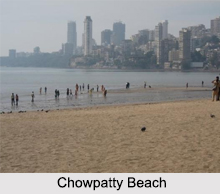 Located in the Girgaon area of MumbaiMarine Drive, at the foot of the Malabar Hills. The beach is not meant for swimming or bathing but is sought after by political, religious and other social groups to host functions.
Located in the Girgaon area of MumbaiMarine Drive, at the foot of the Malabar Hills. The beach is not meant for swimming or bathing but is sought after by political, religious and other social groups to host functions.
The lone surviving terrorist of 26/11 terror attacks, Ajmal Kasab was caught at Chowpatty beach by the brave policeman, Tukaram Omble. On 26th November, 2009, a bronze statue was built at the spot in honour of Tukaram Omble.
Etymology of Chowpatty Beach
Chowpatty comes from the word Chau-pati, which means four channels or creeks. This name is analogous to that of Satpaty, a village in the Mahim Taluka of the Thane District, which is approached through a channel or creek, containing 7 divisions of water.
Attractions in Chowpatty Beach
The Chowpatty beach is a retreat from a tedious routine for many. During the daytime, the beach is flocked by idle groups who loiter and laze around. But as the sun sets, and evening approaches, the beach virtually turns into a fair with food kiosks, shows of professional masseurs, BB-Gun shooting galleries, contortionists, snake charmers and monkey-trainers. The local delicacies such as pav bhaji, pani puri, ragda patties and kulfi are sold at stalls dotting the beach and is an important attraction. Chowpatty beach acts as a hangout for masses in all seasons.
The beach hosts various festivals of the Hindus throughout the year, like the Coconut Festival and the Ganesh Chaturthi. The best time to visit Chowpatty Beach is during this time between the months of October to March. During the festival of Ganesh Chaturthi, thousands of devotees gather around to sing and dance. The idols of Lord Ganesha are immersed into the Arabian Sea as a part of the celebrations. It is also one of the many places in the city where the Ramlila is performed on a stage every year. An effigy of Ravana erected on the sand is burnt at the end of the 10-day performance.
Pollution in Chowpatty Beach
The once beautiful and clean Chowpatty beach is now a heap of trash. The water surrounding the beach is heavily polluted. In 2013, faecal coliform was recorded in the water at levels of 1455 per 100 ml, which is far above the acceptable standard of 500 per 100 ml. The presence of faecal coliform in the water has been attributed to waste from storm drains, open defecation, and the discharge of raw sewage from the sewer pipes not connected to the city mains.
On 30 August 2016, the sand on the beach is said to be turning black due to a possible oil slick in the area. The specific cause of the blackening is unknown. Recently around June, 2018, the Bombay High Court issued a 13 year old restriction on the Chowpatty beach from holding any kind of public events except religious ones like the Ganpati and Durga immersions, Ram Leela, Krishna Leela and Christmas event. For other functions, one has to take the court"s permission. The court also asked the Maharashtra government, the Bombay Municipal Corporation (BMC) and the Mumbai Port Trust to tackle the erosion on the northern end of the beach and restore it within 2 months.
Visiting Information for Chowpatty Beach
The nearest railway station to Chowpatty beach is the Churchgate Station. From here, one can board a local train to Charni Road and walk from there to the beach. Chowpatty beach is also well connected by roads.



















